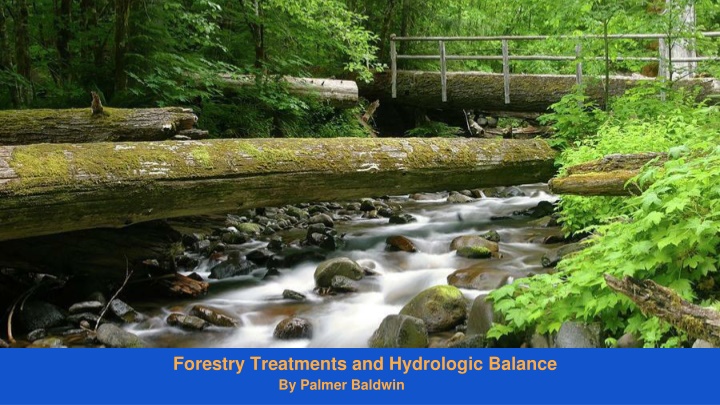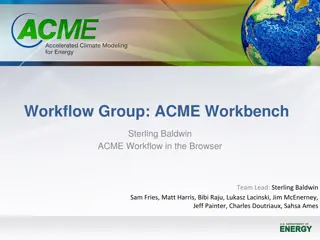
Hydrologic Balance in Forestry Treatments: Components and Responses
Explore the hydrologic balance in forestry treatments with a focus on components like forest canopy, snowpack, soil, and regolith. Learn about the water inputs and outputs, effects of forest canopy removal, snowpack dynamics, and responses to environmental changes.
Uploaded on | 0 Views
Download Presentation

Please find below an Image/Link to download the presentation.
The content on the website is provided AS IS for your information and personal use only. It may not be sold, licensed, or shared on other websites without obtaining consent from the author. If you encounter any issues during the download, it is possible that the publisher has removed the file from their server.
You are allowed to download the files provided on this website for personal or commercial use, subject to the condition that they are used lawfully. All files are the property of their respective owners.
The content on the website is provided AS IS for your information and personal use only. It may not be sold, licensed, or shared on other websites without obtaining consent from the author.
E N D
Presentation Transcript
Forestry Treatments and Hydrologic Balance By Palmer Baldwin
Table of Contents Hydrologic Balance of forest basins Responses to forest canopy removal Experimental design/results Discussion Conclusion Watershed 1 before logging, looking up south tributary above the forks. Photographed by Dick Fredriksen 07/1962 Photo: AAB-020
Components of Water Balance Storage Locations Forest Canopy Snowpack Soil and Regolith Movement Mechanisms Precipitation Evaporation Transpiration Snowmelt Throughfall
Forest Canopy Water Input: precipitation, cloud water interception Water output: evaporation, throughfall Image retrieved 4/13/2019 courtesy of https://www.nsf.gov/news/mmg/mmg_disp.js p?med_id=73771&from=
Snowpack Image retrieved 4/13/2019 courtesy of https://andrewsforest.oregonstate.edu Water Input: Throughfall Water output: Evaporation, Snowmelt
Soil and Regolith Debris flow from WS 3, photographed by Al Levno (Feb. 7, 1996), photo AAD-042, HJ Andrews Experimental Forest research program. Retrieved 4/13/2019 courtesy of http://common-place.org/book/at-the-experimental-forest/ Water input: Throughfall, Snowmelt Water output: Evaporation, Transpiration
Responses to Forest Canopy Removal Evapotranspiration effect: Reduces canopy storage Increases throughfall to soil Reduces evapotranspiration Decreases cloud water interception Cloud water interception effect: Decreases cloud water interception (seasonal) Photo: HJA watershed 1 after forest removal, 07/1966. Dick Fredriksen. accessed 4/13/2019. andrewsforest.oregonstate.edu/sites/default/files/lter/research/component/veg/vegscpic.htm
Responses continued Snowpack Dynamics Effect: Decreased canopy evaporation Increased snowpack accumulation/storage Rain-on snow-events= increased soil moisture and runoff Subsurface Flow interception effect Road construction= canopy gaps Alters water routing to streams
Experimental design 14 experimental basins, 3 LTERs (HJA, Fox Creek, Coyote Creek) Looking for changes in average magnitude of peak discharge events Size of event= 0.22-0.28 (4-5 largest peak discharge events/year) 100%, 50%, and 25% forest canopy removal groups Basins being studied in this experiment. From: JA Jones, 2000
Results Large increases in peak discharge after forest canopy removal Decreasing effect over time Proportional to canopy removal percentages Consistent in all 3 locations Photo: HJA Watershed 1, 20 years following slash burning, 04/1986. Al Levno, AAB-032 accessed 4/113/2019. https://andrewsforest.oregonstate.edu/sites/default/files/lter/research/component/veg/vegsc pic.htm
Conclusion Increased canopy removal=increased runoff Increased roads=increased runoff Roads reroute surface and subsurface water flow Aerial oblique of Watershed 1, 24 years following slash burning. Photographed by Al Levno ..... Date: 07/16/1990 Photo: AAB-033
Acknowledgments Title slide: Lookout Creek, The H. J. Andrews Experimental Forest And Long-term Ecological Research Site. Photograph by Robert Mutch, accessed 4/2/2019 from https://fineartamerica.com/featured/lookout- creek-the-h-j-andrews-experimental-forest-and-long-term-ecological-research-site-robert-mutch.html






















